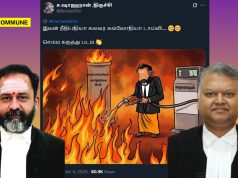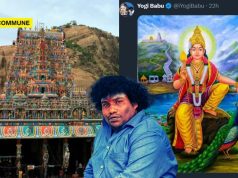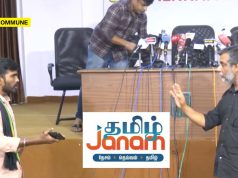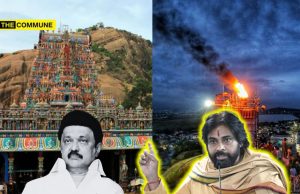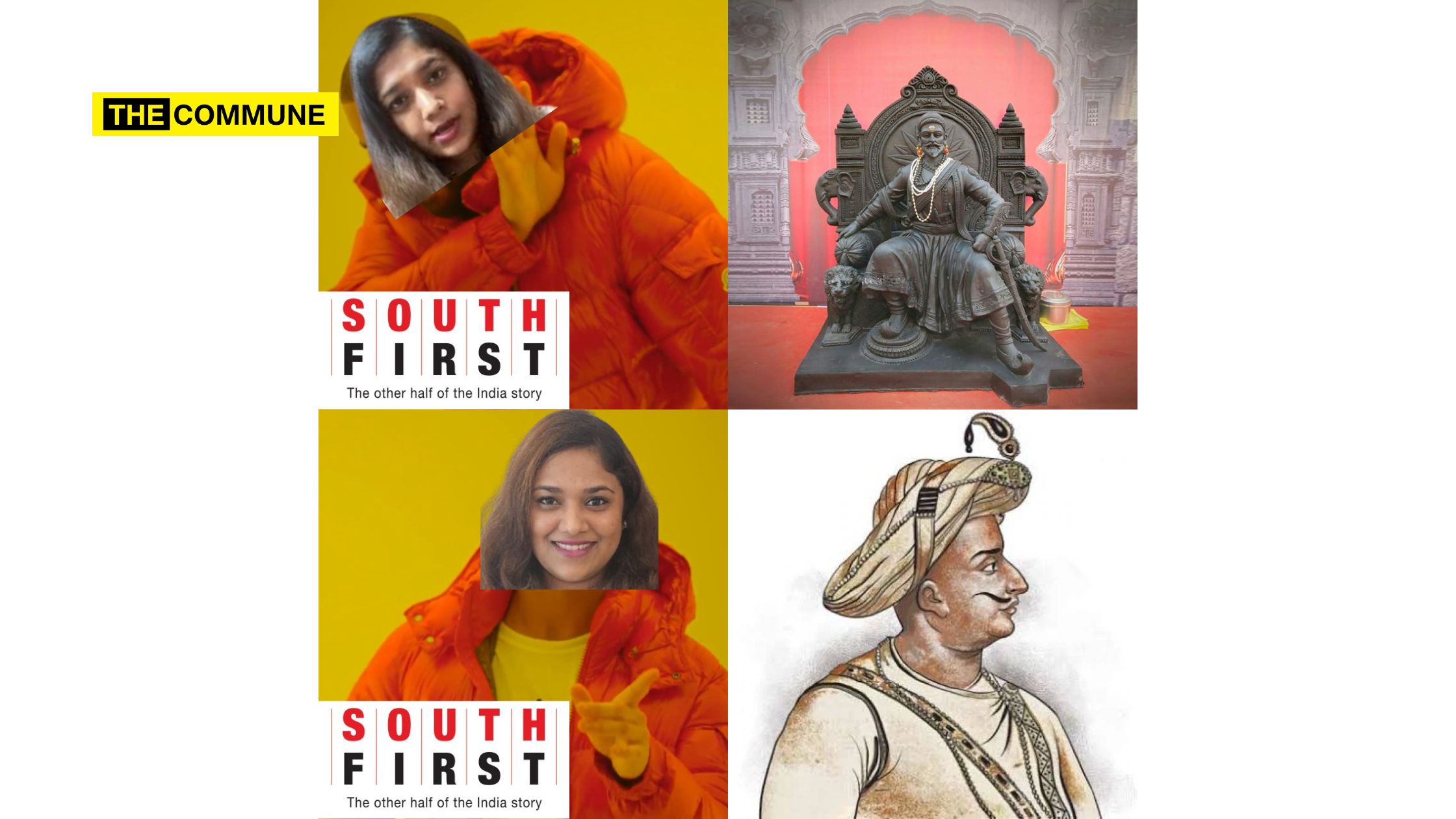
Brown sepoys and Mughal slaves still exist in the country whose only duty is to praise their masters even if they live in a free country. It becomes especially important if a Hindu icon is praised or worshipped. 19 February 2025 was celebrated across the country as Shiv Jayanti commemorating the birth anniversary of Chhatrapati Shivaji Maharaj.
Royal scion of the Wadiyar dynasty and Lok Sabha MP Yaduveer Wadiyar posted on his official X handle to mark the occasion. He wrote, “Chhatrapati Shivaji Maharaj, an architect of Hindavi Swarajya, a fearless warrior, and a visionary leader who defied tyranny to establish a just and prosperous Maratha kingdom. His governance, military strategies, and unwavering commitment to dharma continue to shape India’s spirit of resilience and self-rule. His ideals of Swarajya, justice, and good governance laid the foundation for a strong and self-reliant nation. On his birth anniversary, I bow in reverence to the great Chhatrapati, whose legacy continues to inspire generations. May we always walk the path of courage, righteousness, and devotion to our motherland.”
Chhatrapati Shivaji Maharaj, an architect of Hindavi Swarajya, a fearless warrior, and a visionary leader who defied tyranny to establish a just and prosperous Maratha kingdom.
His governance, military strategies, and unwavering commitment to dharma continue to shape India’s… pic.twitter.com/ASwWvrvaTi
— Yaduveer Wadiyar (@yaduveerwadiyar) February 19, 2025
However, the editor of South First and a newly entered duplicate of TNM’s Dhanya Rajendran, Anusha Ravi Sood made a comment. She wrote, “When political compulsions force you to forget historical facts. Marathas have a long history of attacking Kannadigas, including Wodeyars, plundered temples, ransacking mathas.”
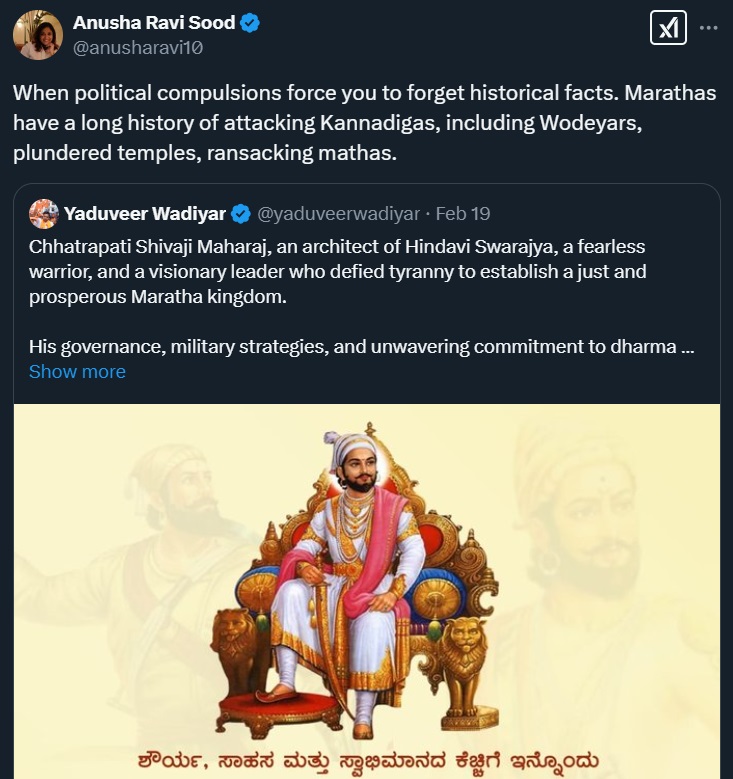
Well, let us take this opportunity to educate Ms Sood on facts and true history.
Chhatrapati Shivaji Maharaj was the Hindu warrior who dreamt of Hindavi Swarajya. So any sane person would never believe words like he destroyed Mathas and attacked Kannadigas, especially the Wodeyars, and plundered temples – feels ridiculous to even hear those words.
Let us go one by one:
1 – Did Marathas Attack Kannadigas, The Wodeyars?
The Maratha presence in Karnataka was extensive, particularly during the 17th and 18th centuries. Bengaluru itself was under Maratha control for a significant period. During Shivaji Maharaj’s reign and beyond, the Marathas expanded their influence into parts of Karnataka, including Bijapur, Mysore, and the Western Ghats. These campaigns were largely directed at countering the Deccan Sultanates and the Mughal Empire.
From 1638 to 1664, Bengaluru remained a jagir (fiefdom) of Shahaji Raje, awarded to him by the Bijapur Sultanate.
Chhatrapati Shivaji never fought Chikkadevaraya Wodeyar of Mysore; it was his son, Chhatrapati Sambhaji, who engaged in conflict with him. The Marathas emerged victorious, forcing Chikkadevaraya to sign a peace treaty with Sambhaji.
2 – Did Marathas Plunder Temples?
One of the recurring claims made against the Marathas is that they looted temples such as Tirumala Tirupati allegedly to please their Muslim overlords during the so-called “invasion” of Vijayanagar. However, this claim falls apart when examined in a historical context.
The alleged incident took place before the birth of Chhatrapati Shivaji Maharaj’s father, Shahaji Bhosale, who was born in 1594—14 years after the supposed event. At that time, the Maratha Empire did not even exist, making it historically inaccurate to associate them with this plundering.
While it is true that some Maharashtrians served as mercenaries under Muslim rulers, this does not mean the Marathas as a polity were anti-Hindu. Similar examples exist among Rajputs, who fought alongside the Mughals, yet they remained some of the strongest resistors to Islamic invasions.
Moreover, historical records highlight the Marathas’ significant role in temple restoration and patronage. Rani Ahilyabai Holkar, for example, was responsible for rebuilding hundreds of temples across India, including the Kashi Vishwanath Temple. In fact, 7 out of the 12 Jyotirlinga temples were either restored or rebuilt by the Marathas. They also played a crucial role in constructing or renovating several ghats in Kashi, effectively shaping modern-day Varanasi in the 18th century.
Shahaji Raje, under the Bijapur Sultanate, built several temples in Bangalore, such as the Kadu Malleshwara Temple. Even under the Portuguese-controlled Goa, Shivaji Maharaj took the initiative to restore the Saptakoteshwar Temple.
This thread is full of lies about Marathas as posted by @mardparatha69 .
In this thread I show how he is spreading fake information.
1) Marathas plundered Tirupati?
No! The temple website (snippet is attached) says:
“The Maratha general, Raghoji Bhonsle, visited the temple… https://t.co/TPyoWQ4BXx pic.twitter.com/sRkkxLcpLJ
— Aabhas Maldahiyar 🇮🇳 (@Aabhas24) August 20, 2023
Here is a list of temples that the Marathas rebuilt/restored during the 18th century.
- Shri Mahalakshmi Temple (Kolhapur) – Restored and re-inaugurated in 1715 by Maharani Tarabai.
- Shri Vitthal Mandir (Pandharpur) – Reconstructed in 1715 by Chhatrapati Shahu after being demolished by Aurangzeb in 1705.
- Trimbakeshwar (near Nashik) – Rebuilt by Peshwa Balaji Bajirao (Nanasaheb) in the early 18th century.
- Saptakoteshwar Temple (Narve, Goa) – Rebuilt by Chhatrapati Shivaji in 1668 after being destroyed by the Portuguese.
- Shri Shantadurga Temple (Kavale, Goa) – Rebuilt in the 1720s by Chhatrapati Shahu’s minister Naro Ram, later expanded in the 1730s.
- Shri Mangesh Temple (Goa) – Reconsecrated in the 1740s after being relocated due to Portuguese persecution.
- Ghrishneshwar Temple (Verul, Maharashtra) – Rebuilt by Maloji Raje Bhosale in the 16th century, reconstructed by Gautamabai Holkar in 1730 and renovated by Ahilyabai Holkar in 1769.
- Mahakaleshwar Temple (Ujjain) – Rebuilt in the 1730s by Ramchandra Malhar under Ranoji Shinde’s rule.
- Shri Jagannath Temple (Puri, Odisha) – Protected by Marathas after taking control of Odisha in 1751; the Rath Yatra was revived.
- Surya Mandir (Konark, Odisha) – Marathas played a role in shifting the Arun Stambha (pillar) from Konark to Puri to protect it.
The Marathas played a crucial role in temple restoration, ensuring the revival of Hindu worship sites across India. We even have the case of Chhatrapati Sambhaji Maharaj in Chidambaram.
3- Did Marathas Ransack Mathas?
A long-standing myth suggests that the Marathas plundered the Sringeri Mutt, but a closer look at historical records refutes this claim.
The real perpetrators of the attack were Pindaris, who were not part of the regular Maratha forces. Pindaris were mercenaries from various communities, including the Lamani tribe, and were known for their predatory practices. Similar irregular troops, called Bayed, operated in Tipu Sultan’s army, performing looting operations after battles. These troops were unpaid and survived by plundering.
During the Sringeri incident, Parshuram Patwardhan Bhau was leading the Maratha forces. While he was accused of failing to control the Pindaris who followed his army, it is documented that the Lamani Pindaris acted on their own accord in raiding the Mutt and fleeing with the loot.
Contrary to claims that the Marathas were complicit in this act, records indicate that regular Maratha soldiers actually pursued the Lamani Pindaris to recover the stolen relics, though they were ultimately unsuccessful.
Historian V.V. Khare, who compiled a vast collection of letters, wrote that the Sringeri Mutt was widely considered a safe repository for wealth because it was believed that the Marathas, being Hindus led by Brahmin commanders, would not harm it. While the irregular Pindari troops acted unchecked, the Maratha leadership did not sanction the attack.
Further evidence comes from A.K. Shastry, editor of The Records of the Sringeri Dharmasamsthana, who states that Peshwa Madhavrao Narayan personally conducted an inquiry into the incident. His letter to Parshuram Bhau ordered compensation and the return of the looted articles. Parshuram Bhau responded positively, reinforcing that the incident was not a deliberate act by the Marathas but the work of predatory Pindari elements.
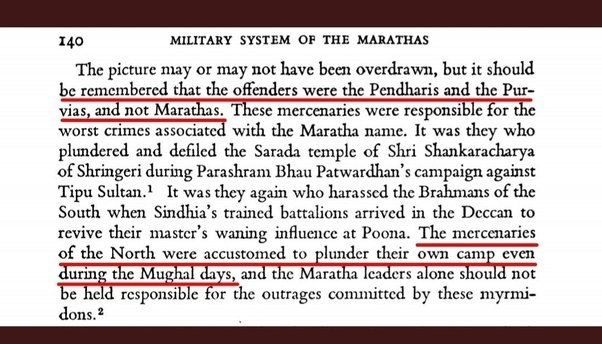
Moreover, the Maratha leadership showed remorse and actively sought to compensate the Sringeri Mutt. Efforts to restore relations continued for nearly a year, culminating in a visit by the Sringeri Acharya to Pune. The official website of the Sringeri Mutt itself acknowledges the generosity of the Marathas toward the Mutt, further debunking the claim that the Marathas deliberately plundered it.
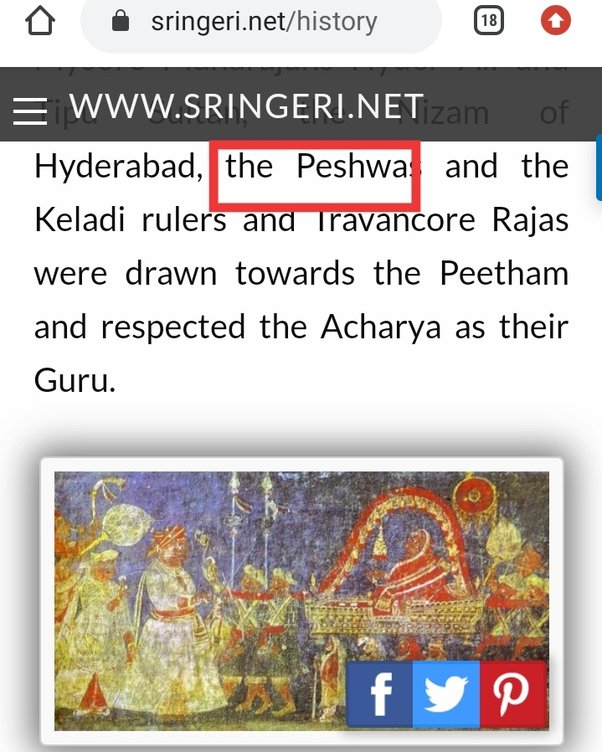
This record from Sringeri Matha tells what exactly happened in 1791 & why it happened with reparations given by the same Marathas along with apology. I’m sure many realities will come out once Olata propaganda is busted.
All Tipu Gulams will be taken to cleaners. https://t.co/4yogxJaAzx pic.twitter.com/Y3hRLIk5zp
— 🇳🇪🇴🇳🇹🇪🇦🇱 (@Neonteal1) February 19, 2025
On the other hand, when it was about Tipu Sultan, she praised him for “terrorising the British“. Back in 2022, she wrote, “Contributions of Wodeyars to Karnataka’s infrastructure has been immense but Tipu Sultan was one of the most formidable, brave Indian rulers who terrorised British. One could have honoured Wodeyars without this pettiness of denying Tipu’s legacy.”
Contributions of Wodeyars to Karnataka’s infrastructure has been immense but Tipu Sultan was one of the most formidable, brave Indian rulers who terrorised British. One could have honoured Wodeyars without this pettiness of denying Tipu’s legacy. https://t.co/wD5SQWkwVl
— Anusha Ravi Sood (@anusharavi10) October 9, 2022
Let’s give Anusha Ravi Sood a lesson in real Tipu history.
What Is The Reality Of Tipu Sultan?
Tipu Sultan, the ruler of Mysore from 1782 to 1799, is often recognized by leftists for his “resistance against the British“, but his rule was marked by severe persecution of Hindus and other non-Muslims. His policies included forced conversions, temple destructions, massacres, and discriminatory taxation, leaving a lasting impact on these communities.
Forced Conversions
Tipu Sultan implemented large-scale forced conversions, particularly in Malabar, Coorg, and coastal Karnataka. In Malabar (1788–1792), historical records indicate that around 70,000 Hindus were forcibly converted, as documented in Sir William Logan’s Malabar Manual. His letters explicitly instructed officials to seize Brahmins and convert them. In Coorg (1785), nearly 80,000 Kodavas were captured and converted, significantly affecting their cultural and demographic structure.
Temple Destruction
Several Hindu temples suffered destruction or desecration under Tipu Sultan’s rule. The Sringeri Sharada Peetham (1791) was attacked, and its pontiff pleaded for protection through letters. The Kollur Mookambika Temple and Varaha Narasimha Temple in Srirangapatna were also damaged, leading to religious suppression.
The record of Tipu Sultan’s temple destruction in South India is perhaps best summed up by B. Lewis Rice, the eminent British epigraphist and director of the Archaeology Department of the British Government:
“In the vast empire of Tipu Sultan on the eve of his death, there were only two Hindu temples having daily pujas within the Sreerangapatanam fortress. It is only for the satisfaction of the Brahmin astrologers who used to study his horoscope that Tipu Sultan had spared those two temples. The entire wealth of every Hindu temple was confiscated before 1790 itself mainly to make up for the revenue loss due to total prohibition in the country.”
Tipu’s iconoclasm was not limited to a few instances—it was a systemic policy. According to Lewis Rice’s Mysore Gazetteer, Tipu destroyed approximately 8,000 Hindu temples in South India. Colonel R.D. Palsokar confirms this number in his study, noting that Tipu Sultan himself boasted about the destruction:
“Tipu relates that he had destroyed 8,000 temples, many of them with roofs of gold, silver, copper and all containing treasures buried under the idols. The Raja of Cherakal offered him Rs. 400,000 and the plates of gold with which one particular temple was roofed but Tipu said that he would not spare it for all the treasures of the earth and sea.”
This refusal to spare temples even for immense wealth mirrors Muhammad Ghaznavid’s attitude, who once declared:
“I desire that on the day of resurrection I should be summoned with the words ‘Where is that Mahmud who broke the greatest of heathen idols?‘ rather than by these: ‘Where is that Mahmud who sold the greatest of the idols to the infidels for gold?‘”
He specifically desecrated the Guruvayur temple in Kerala. According to Illustrated Weekly of India (2 January 1977):
“The truth is that when Tipu raided the Malabar, he looted all the gold and jewelry in the Hindu temples there, pulled down the gold, silver, and copper covering that was placed on the roofs of these temples, looted their money, and vandalized them. Seeing the nature of his raid, the locals and Brahmins at Guruvayoor feared for the fate of the idol of Krishna in the temple, shifted it to Ambalapuzha, and hid it.”
Here is a list of some of the major temples in the Malabar region he destroyed.

Massacres and Oppression
Tipu Sultan’s campaigns resulted in large-scale massacres of Hindus.
The Melukote Massacre of 1790 was a tragic event in which Tipu Sultan’s forces slaughtered over 700 Mandyam Iyengar families on Naraka Chaturdashi, the day of Diwali. The Mandyam Iyengars, a community of Srivaishnava Brahmins, had settled in Melukote, Karnataka, due to its prominence as a religious and educational center, closely associated with Ramanujacharya.
During Tipu Sultan’s rule, tensions escalated, culminating in the massacre at the Narasimhaswamy Temple in Srirangapatna. Families who had gathered to celebrate Diwali were mercilessly butchered, including women and children. Survivors fled to nearby villages like Nagamangala before resettling in Melukote.
To this day, the town does not celebrate Diwali, marking it instead as a day of mourning. The massacre is a stark reminder of Tipu Sultan’s persecution of Hindus, which included forced conversions, temple destruction, and mass killings across his dominion. While some defend Tipu’s legacy by citing his patronage of certain temples and Hindu officials in his administration, historical records, including Tipu’s own letters, reveal his deep-seated religious fanaticism. He openly celebrated the forced conversion of thousands of Hindus and the destruction of temples that obstructed Islamic structures.
The Coorg Massacre, also known as the Devati Paramb genocide, was a brutal attack on the Kodava people by Tipu Sultan in 1785. Tipu Sultan, who raided Kodagu multiple times but faced resistance, lured the Kodavas into a truce meeting at Devati Paramb. Trusting his word, over 1.1 lakh Kodavas gathered unarmed, only to be ambushed by Tipu’s hidden army. Around 60,000 Kodavas were massacred, while 90,000 were taken as prisoners. Many perished in Srirangapatna’s jails, while others faced forced conversions, torture, and enslavement. Young women were taken by Tipu’s soldiers, and young men were forcibly incorporated into his army. Tipu also destroyed temples in Kodagu, forcibly converted Kodavas to Islam, and attempted to erase Kannada culture by imposing Persian in administration.
The Malabar Invasion & Massacre (1788–1792)
Tipu Sultan’s invasion of the Malabar region led to widespread destruction and massacres, particularly in Kozhikode. His forces killed around 2,000 Brahmins and forced many others to flee into the jungles. Tipu’s attacks led to the destruction of numerous Hindu temples. Many temples were demolished, idols were desecrated, and some were converted into mosques, as documented in William Logan’s Malabar Manual. Portuguese missionary Fr. Bartholomew recorded Tipu’s brutal methods, including hanging women and children and tying victims to elephants to be torn apart. Tipu’s letters reveal his intent to forcibly convert Hindus to Islam, describing his actions as a jihad. In a letter to Budruz Zaman Khan, he wrote that nearly all Hindus in Calicut had been converted, with plans to do the same in Cochin. His genocidal policies wiped out entire villages and destroyed the region’s prosperous spice trade.
After he died in 1799, British forces found around 2,000 of Tipu’s letters, in which he referred to Hindus as “kaffirs” and called for their extermination. His correspondence with the French and Ottoman Empire showed his efforts to bring foreign powers to aid his cause. Contrary to his portrayal as a patriot, Tipu was a religious fanatic whose reign resulted in the mass slaughter and forced conversion of Hindus in Malabar.
We hope Anusha Ravi Sood takes the time to educate herself and refrains from spreading lies and propaganda in the future. A journalist’s duty is to uphold the truth, not distort it.
Subscribe to our channels on Telegram, WhatsApp, and Instagram and get the best stories of the day delivered to you personally.

